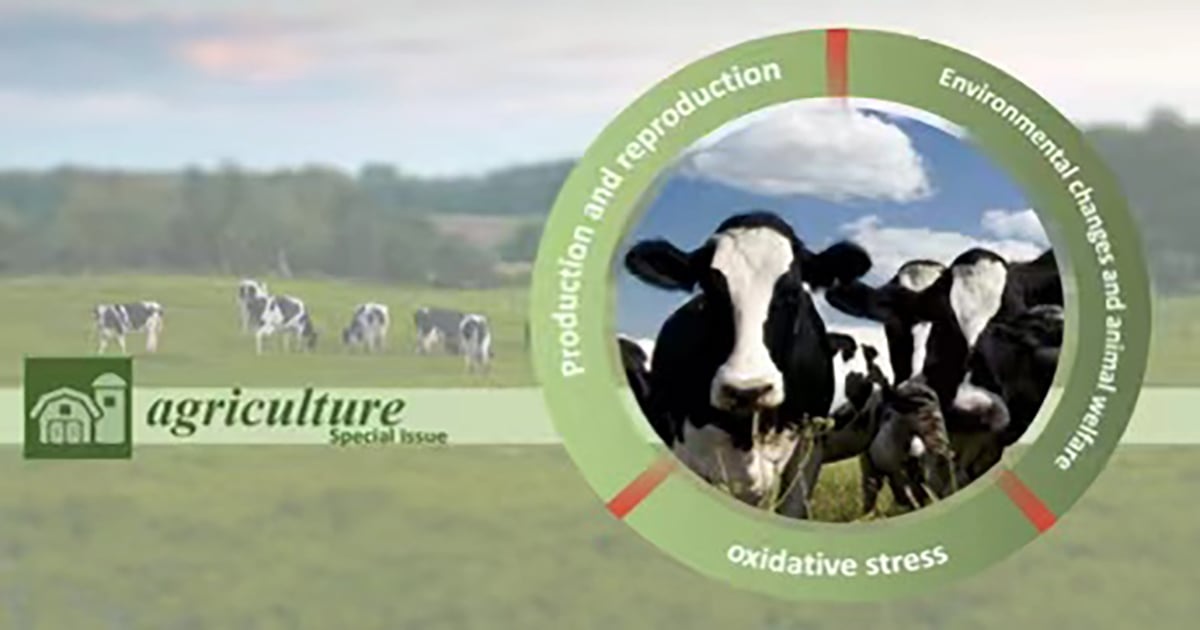Impacts of Oxidative Stress on Cattle Physiology
A special issue of Agriculture (ISSN 2077-0472). This special issue belongs to the section "Farm Animal Production".
Deadline for manuscript submissions: closed (10 January 2025) | Viewed by 2670

Special Issue Editors
Interests: oxidative stress; bioactive compounds; phytopharmaceuticals; method validation; quality management
Special Issues, Collections and Topics in MDPI journals
Interests: natural antioxidants; oxidative stress; reactive oxygen species; in vitro antioxidant tests; lipophilic compounds; chromatograph
Special Issues, Collections and Topics in MDPI journals
Interests: oxidative stress; in vitro and in vivo antioxidant activity; antioxidant enzymes; natural antioxidants
Special Issues, Collections and Topics in MDPI journals
Special Issue Information
Dear Colleagues,
The field of oxidative stress in ruminant medicine is still in its early developmental stages. Although oxidative stress has been linked to various conditions, much remains to be uncovered about its role in ruminant health and production. Determining whether oxidative stress is a primary cause of pathologic changes or a consequence of disease processes is still a matter of investigation. Dairy cattle undergo significant physiological changes during their one-year life cycle after reaching adulthood. Various stages, including breeding, pregnancy, fetal growth and development, parturition, and lactation, expose dairy animals to substantial influences of metabolic changes. The considerable oxygen requirements during periods of increased metabolic demand lead to an augmented production of reactive oxygen species (ROS). An imbalance between increased ROS production and the availability of antioxidant defenses may expose cows to heightened oxidative stress.
The goal of this Special Issue is to provide new advances connecting alterations in the pattern of antioxidants and scavenger compounds, mitochondrial dysfunction, imbalance of energy metabolism, and oxidative stress with onset and/or progression of cattle production systems, also taking into consideration the impact of environmental conditions on cattle welfare in the context of a changing climate.
There is a link between oxidative stress and the epigenetic landscape of the cell due to the consequences of ROS accumulation on the methylome, so globally oxidative stress can influence the cell even on DNA or histone levels. The mitochondria, the main intracellular source of ROS through ATP production, can be affected by epigenetic modification, the so called mitoepigenetic modifications having a connection between oxidative stress and the mitochondrial function on somatic cells and on germinative cells.
Papers reporting data on metabolic changes interconnected with the oxidative process in critical life-stage periods (sexual maturity/cyclicity, pregnancy, parturition, puerperal period, lactation, service period), in vitro fertilization as well as thermal stress are highly welcome.
Prof. Dr. Camelia Tulcan
Prof. Dr. Adela Pintea
Prof. Dr. Sanda Andrei
Guest Editors
Manuscript Submission Information
Manuscripts should be submitted online at www.mdpi.com by registering and logging in to this website. Once you are registered, click here to go to the submission form. Manuscripts can be submitted until the deadline. All submissions that pass pre-check are peer-reviewed. Accepted papers will be published continuously in the journal (as soon as accepted) and will be listed together on the special issue website. Research articles, review articles as well as short communications are invited. For planned papers, a title and short abstract (about 100 words) can be sent to the Editorial Office for announcement on this website.
Submitted manuscripts should not have been published previously, nor be under consideration for publication elsewhere (except conference proceedings papers). All manuscripts are thoroughly refereed through a single-blind peer-review process. A guide for authors and other relevant information for submission of manuscripts is available on the Instructions for Authors page. Agriculture is an international peer-reviewed open access semimonthly journal published by MDPI.
Please visit the Instructions for Authors page before submitting a manuscript. The Article Processing Charge (APC) for publication in this open access journal is 2600 CHF (Swiss Francs). Submitted papers should be well formatted and use good English. Authors may use MDPI's English editing service prior to publication or during author revisions.
Keywords
- cattle
- oxidative stress
- ROS
- epigenetics
- dairy production
- reproduction
- heat stress
Benefits of Publishing in a Special Issue
- Ease of navigation: Grouping papers by topic helps scholars navigate broad scope journals more efficiently.
- Greater discoverability: Special Issues support the reach and impact of scientific research. Articles in Special Issues are more discoverable and cited more frequently.
- Expansion of research network: Special Issues facilitate connections among authors, fostering scientific collaborations.
- External promotion: Articles in Special Issues are often promoted through the journal's social media, increasing their visibility.
- e-Book format: Special Issues with more than 10 articles can be published as dedicated e-books, ensuring wide and rapid dissemination.
Further information on MDPI's Special Issue policies can be found here.







